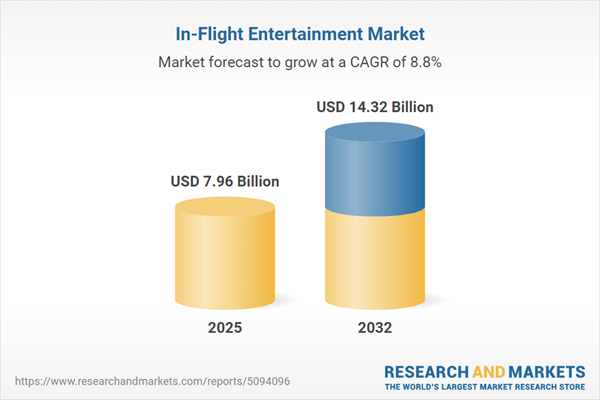Speak directly to the analyst to clarify any post sales queries you may have.
The in-flight entertainment market is swiftly advancing as airlines adopt digital platforms and reliable connectivity to redefine cabin experiences and drive operational efficiency. Senior decision-makers are utilizing advanced systems to enhance passenger engagement, streamline internal processes, and align with dynamic industry standards.
Market Snapshot: Growth and Outlook for the In-Flight Entertainment Market
The in-flight entertainment market is experiencing accelerated growth, propelled by increasing airline investment in digital transformation. Enhanced passenger expectations for on-demand media and uninterrupted connectivity are shaping modernization initiatives. Airlines are investing in content-rich, personalized experiences to build brand loyalty and swiftly adapt to changing traveler behaviors. Creative infotainment offerings and immersive multimedia are quickly becoming central to airline strategies, allowing consistent competitive differentiation as the industry evolves.
Scope & Segmentation: Strategic Levers in the In-Flight Entertainment Market
This report offers senior executives a structured framework to inform investment, operational planning, and product strategy across all facets of the in-flight entertainment landscape:
- Hardware Type: Seatback screens, handheld devices, and wireless modules enable flexible deployment in diverse aircraft types and allow airlines to customize passenger journeys for new and retrofit fleets.
- Content Type: Expansive media libraries feature films, live TV, interactive games, and varied audio, meeting the needs for multilingual access and regional compliance to amplify passenger satisfaction.
- Connectivity Type: Advanced in-flight Wi-Fi alongside integrated 4G and 5G technologies ensures constant access to entertainment and personal services, supporting productivity and digital engagement.
- Aircraft Type: Tailored entertainment configurations for wide-body, narrow-body, and regional jets are designed to address route profiles and capacity requirements, ensuring optimal onboard experiences.
- Cabin Class: Customizable solutions address first, business, premium economy, and economy classes, unlocking new ancillary revenue opportunities through differentiated features and exclusive content.
- Regional Coverage: Strategies across the Americas, Europe, Middle East & Africa, and Asia-Pacific address distinct operational priorities, infrastructure, and regulatory contexts, enabling responsive product adaptation per market.
- Company Coverage: Competitive benchmarking spans major technology providers including Panasonic Avionics, Thales S.A., Safran S.A., Collins Aerospace, Viasat, Gogo Inc., Lufthansa Systems, Global Eagle, Inmarsat, and Intelsat, examining their strategic direction and technological breadth.
Key Takeaways: Insights for Senior Decision-Makers
- Digital entertainment systems drive personalized passenger experiences and present opportunities for value-added offerings and ancillary services.
- Platforms compatible with both embedded solutions and personal devices offer airlines the adaptability and simplified maintenance needed for diverse fleet compositions.
- Strategic partnerships with technology vendors and content producers foster ongoing innovation, regulatory alignment, and faster deployment of features and upgrades.
- Comprehensive, accessible content accommodates regional requirements and expands airline reach to global travelers, driving sustained engagement.
- Premium cabins particularly benefit from robust, continuous in-flight connectivity, meeting demands from productivity-oriented and leisure travelers while reinforcing service quality.
- Adoption of sustainable materials and efficient platform designs signals industry focus on responsible growth and enhances stakeholder trust.
Tariff Impact: Navigating U.S. Tariff Pressures and Supply Chain Considerations
Imminent U.S. tariffs on electronic components, due for implementation in 2025, are prompting airlines and technology suppliers to reevaluate sourcing and supply chain strategies. Emphasis is increasing on diverse sourcing, modular design, and flexible licensing to mitigate risk and sustain business continuity in a shifting regulatory landscape. These approaches are enabling stakeholders to adapt rapidly to evolving compliance demands and sustain uninterrupted service delivery.
Methodology & Data Sources
This analysis uses structured interviews with aviation industry executives, comprehensive secondary research, and expert validation from field specialists. Methodologically robust, it delivers actionable insights focused on digital transformation within airline entertainment systems.
The In-Flight Entertainment Market: Why This Report Matters
- Equips aviation leaders with the intelligence needed for forward-looking decisions tailored to shifting traveler preferences and sector priorities.
- Supplies practical tools for risk management and resource allocation in a market influenced by technology innovation and supply chain shifts.
- Provides clear market intelligence to optimize supplier negotiations and future-proof fleet planning and technology investments.
Conclusion
Investing in innovative in-flight entertainment solutions allows airlines to deliver superior passenger experiences and sustain organizational agility during continued industry change. Aligning technology strategy with evolving market needs will drive lasting relevance and customer satisfaction.
Additional Product Information:
- Purchase of this report includes 1 year online access with quarterly updates.
- This report can be updated on request. Please contact our Customer Experience team using the Ask a Question widget on our website.
Table of Contents
3. Executive Summary
4. Market Overview
7. Cumulative Impact of Artificial Intelligence 2025
Companies Mentioned
The companies profiled in this In-Flight Entertainment market report include:- Panasonic Avionics Corporation
- Thales S.A.
- Safran S.A.
- Collins Aerospace Inc.
- Viasat, Inc.
- Gogo Inc.
- Lufthansa Systems GmbH & Co. KG
- Global Eagle Entertainment Inc.
- Inmarsat plc
- Intelsat S.A.
Table Information
| Report Attribute | Details |
|---|---|
| No. of Pages | 197 |
| Published | October 2025 |
| Forecast Period | 2025 - 2032 |
| Estimated Market Value ( USD | $ 7.96 Billion |
| Forecasted Market Value ( USD | $ 14.32 Billion |
| Compound Annual Growth Rate | 8.7% |
| Regions Covered | Global |
| No. of Companies Mentioned | 11 |









